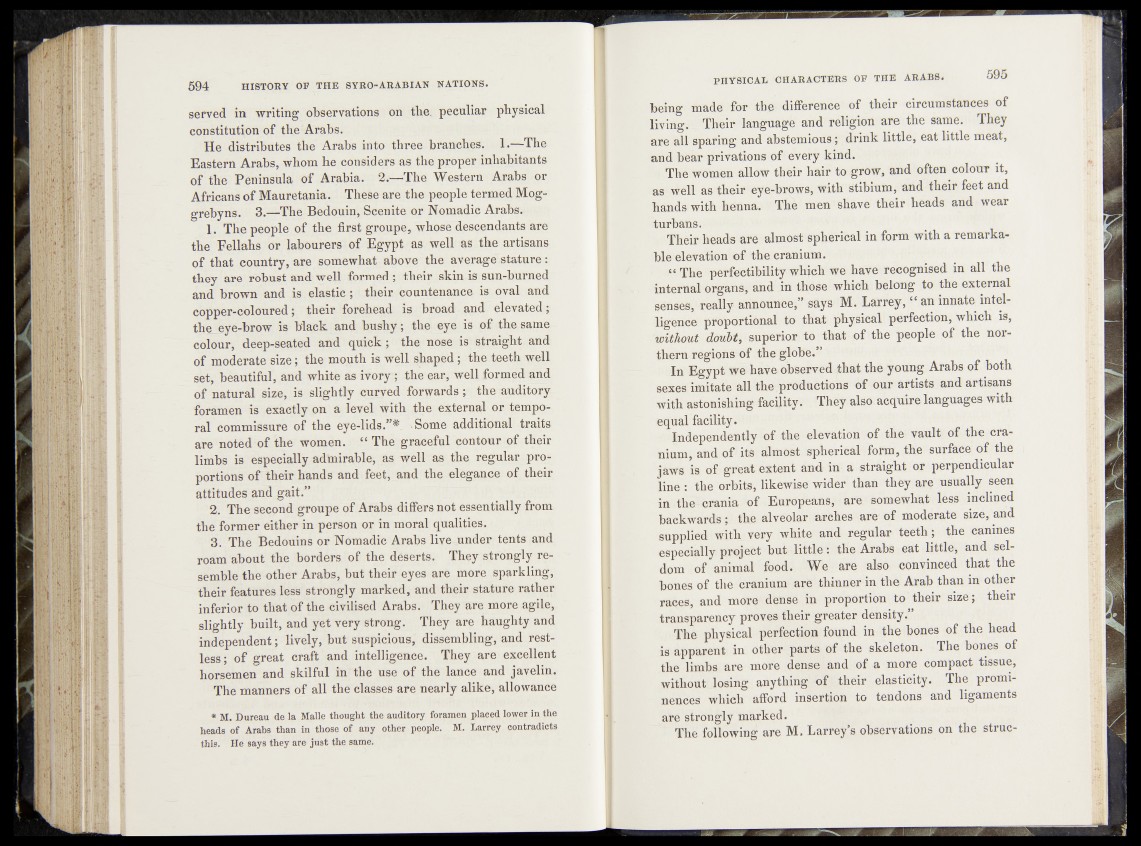
served in writing observations on the: peculiar physical
eonstitution of th,e Arabs.
He distributes the Arabs into three branches. 1.—The
Eastern Arabs, whom he considers as the proper inhabitants
of the Peninsula of Arabia. 2.—The Western Arabs ^or
Africans of Mauretania. These are the people termed Mog-
grebyns. 3.—The Bedouin, Scenite or Nomadic Arabs.*
1. The people of the first groupe, whose descendants are
the Fellahs or labourers of Egypt as well as the artisans
of that country, are somewhat above the average stature :•
they are robust and well formed; their skin is sun-burned
and brown and is elastic ;,* their countenance is oval and
copper-coloured; their forehead is broad and elevated;
the eye-brow is black and bushy; the eye is of the same
colour, deep-seated and quick; the nose is straight and
of moderate size; the mouth is well shaped; tke teeth. well
set, beautiful, and white as ivory; -the ear, well .formed and
of natural size, is slightly curved forwards; the auditory
foramen is exactly on a level with .the external or tempos
ral commissure of the eye-lids.”# Borne additional traits
are noted of the women. “ The graceful contour of their
limbs is especially admirable, as well as the regular proportions
of their hands and feet, and the elegance of their
attitudes and gait.”
2. The second groupe of Arabs differs not essentially from
the former either in person or in moral qualities.
3. The Bedouins or Nomadic Arabs liv&jinder'tents and
roam about the borders of the deserts. They strongly resemble
the other Arabs, but their eyes are more sparkling,
their features less strongly marked, and their stature rather
inferior to that of the civilised Arabs. They are more agile,
slightly built, and yet very strong. They are haughty and
independent; lively, but suspicious, dissembling, and restless;
of great craft and intelligence. They are excellent
horsemen and skilful in the use of the lance and javelin.
The manners of all the classes are nearly alike, allowance
* M. Dureau de la Malle thought the auditory foramen placed lower in the
heads of Arabs than in those of any other people. M. Larrey contradicts
this. He says they are- ju st the same.
being made for the difference of their circumstances of
living. Their language and religion are the same. They
are all sparing and abstemious^;' drink little, eat little meat,
and bear privations of * every kind.
1 The women allow their hair to grow, and often colour it,
as well as their• eye-brows, with stibium, and their feet and
hands with henna. The men shave their heads and wear
turbans.
heads are almost spherical in form with a remarkable
elevation of the cranium.
“ The perfectibility which we have recognised in all the
internal organs, and in those which belong to the external
senses,' really announce;” says M. Larrey, “ an innate intelligence
proportional to that physical perfection, which is,
Without doubt, superior to that of the people of the northern
regions of the globe*”
In Egypt we have observed that the young Arabs of both
sexes imitate all the,productions of our artists and artisans
with astonishing facility. They also.acquire languages with
equal facility. :
Independently of the ' elevation of the vault of the cranium,
and of its almost -spherical form, the- surface of the
jaws is of great extent and in a straight or perpendicular
line : the orbits, likewise wider than they are usually seen
in the crania 'of Europeans, are somewhat less inclined
backwards; the alveolar arches are of moderate size, and
supplied with very white and regular teeth ; the canines
especially project but little: the Arabs eat little, and seldom
of animal food. We are also convinced that the
bones of the cranium are thinner in the Arab than in other
rapes, and more dense in proportion to their size; their
transparency proves their greater density.”
The physical perfection found* in the »bones of the head
is apparent in other parts pf the skeleton. The bones of
the limbs are more dense and of a more compact tissue,
without losing anything of their elasticity. The prominences
which afford insertion to tendons and ligaments
are strongly marked. , ^ .
The following are M. Larrey’s observations on the struc